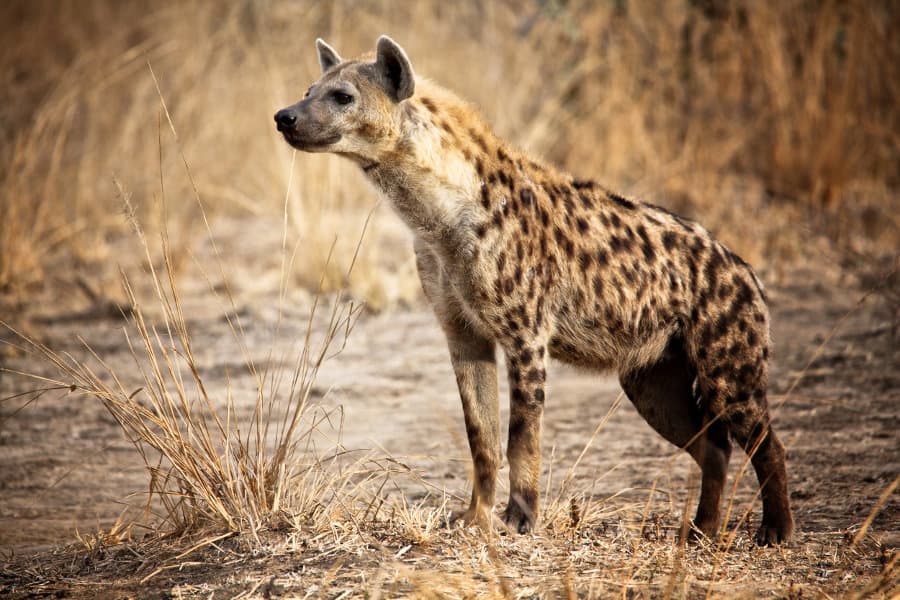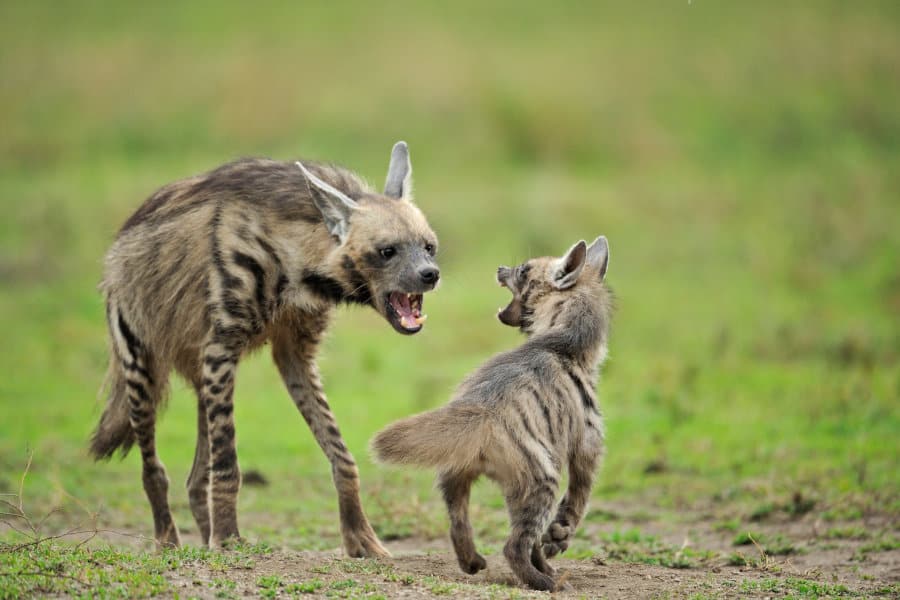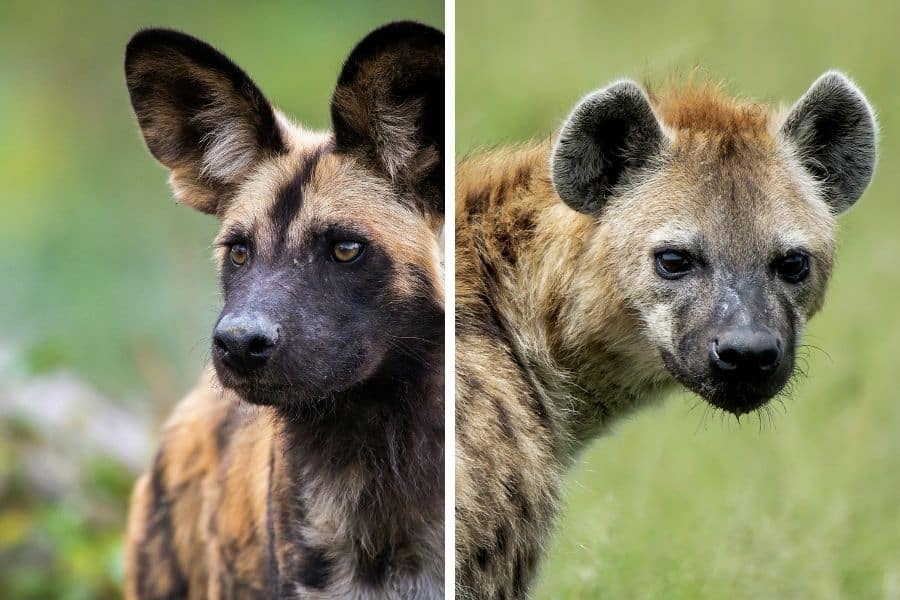Are you on the hunt to find some fascinating spotted hyena facts? This giggly animal is fondly known as the “laughing hyena” and lives in sub-Saharan Africa.
The spotted hyena’s scientific name is Crocuta crocuta. It is the second-largest four-legged predator on the African continent.
Did you know that there are a total of three species of hyena in the Hyaenidae family? These include the spotted hyena, the striped hyena, and the brown hyena.
Spotted hyenas are pack hunters, taking down large plain animals like African antelope, zebra, and wildebeest. They have a powerful bite that can crush a giraffe’s bones.
While these omnivores are well-known as scavengers, they are actually one of the most successful hunters on the savanna.
The spotted hyena is famous for playing the role of giggly villains in cartoon movies. As one of the many spotted animals in Africa, these amazing creatures have some interesting facts worth learning about.
Interesting Facts About Spotted Hyenas
There are many mind-blowing things about these spotted predators, from the hyena’s average weight and size to its quirky physical features and behaviors.
Let’s look at the spotted hyena facts below – some may surprise you.
1. Where do hyenas sleep?

Their homes are versatile. The spotted hyena can live in a range of habitats, including grasslands, woodlands, deserts, mountains, and forests found across sub-Saharan Africa.
The largest population of spotted hyenas live in the Serengeti (Tanzania) and Kruger National Park (South Africa).
Unlike other mammals, spotted hyenas sleep in dens but do not use them for resting. Instead, they find shaded tree canopies or other animals’ vacant holes.
How long do hyenas sleep a day? These animals usually hunt at night (depending on their needs) and rest during the hottest hours of the day.
2. Are hyenas omnivores?
Wondering, “are spotted hyenas omnivores”? As predators, their diet is mostly meat, but many sources classify them as omnivores.
The average meal of a spotted hyena can weigh up to 14.5 kg – that’s a lot of meat. Typical prey of these spotted creatures includes zebra, wildebeest, and various antelope species.
If they cannot find their usual prey, spotted hyenas might hunt and eat fish, snakes, birds, and vegetable matter.
3. This giggly hyena loves to laugh
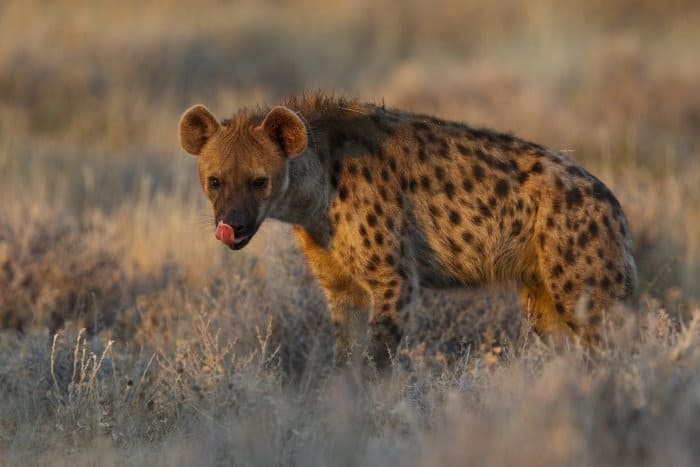
Spotted hyenas are often called “laughing hyenas” because of their distinctive call that sounds like a human laughing.
Their laugh indicates social status amongst their clan members. A clan of hyenas can vary in size but are usually between 80 and 100 members.
Scientists discovered that the tone and pitch of a hyena’s laugh could give an indication of age and social status. They communicate with whoops, cackles, and yells – some can be heard from almost 5 km away.
Hyenas also make 10 other vocalization sounds to communicate with other members of the clan.
4. Spotted hyenas kill baby lions
Hyenas and lions are mortal enemies. They often fight over territories and hunt the same prey.
The fierce competition for resources between these two animals leads to ‘infanticide‘ – the act of killing each other’s young.
5. They are great at problem-solving
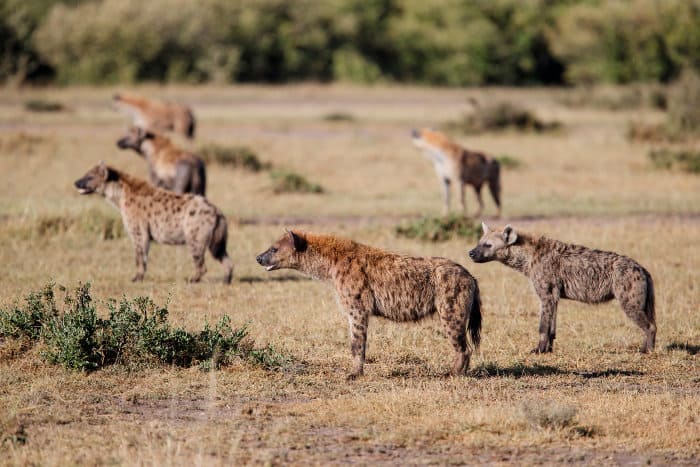
The size of an animal’s frontal cortex relates to its social intelligence. Interestingly, the hyena’s front cortex is similar in size to that of a primate.
A study done by Duke University demonstrated that a captive pair of spotted hyenas showed better social cooperation and problem-solving than primates (chimpanzees).
6. Female hyenas are the alphas
As mentioned, spotted hyenas live together in groups, or in other words, clans. The clan can make up to 80 members, with females being the matriarch or alpha female.
Female hyenas have three times more testosterone in their body than their male counterparts. As a result, their body is more muscular and they display far more aggression than males.
7. The female spotted hyena has male genitalia

The female spotted hyena has an elongated clitoris, also known as a pseudo-penis. Some pseudo-penises grow up to 17.78 centimeters in length.
This can make gender identification difficult because the female genitalia superficially mimics the male reproductive organs.
8. Spotted hyenas aren’t just graveyard lurkers
Spotted hyenas hunt and kill in packs, often isolating and chasing down old and weak prey. Regardless of what Simba would like you to believe, spotted hyenas don’t only scavenge for lions’ leftovers.
They hunt and kill 95 percent of their prey – reaching a top speed of 60 km/h when chasing their next meal.
A pack of spotted hyenas can devour an entire antelope in under half an hour, leaving no leftovers. This includes their skins, hooves, and bones. They also eat lizards, snakes, insects, and birds.
Spotted hyenas have unique acids in their stomach, allowing them to digest materials such as bones – whereas other animals cannot. Hyenas can eat one-third of their body weight – a rather large mouthful.
9. The giggly spotted hyena has a super-strong jaw and teeth

Are you curious to know a few fascinating hyena teeth facts? Hyenas have sharp teeth and jaws. In fact, the spotted hyena’s jaw is one of the strongest in the entire animal kingdom.
They can chomp through about every part of their prey, except the horns. Their feces are white as snow from all the calcium they eat.
10. The hyena’s birthing process is dangerous
The female hyena has a gestation period of three and a half months and gives birth to one or two cubs (per litter) per year. A newborn cub usually weighs around 1.5 kg and is not weaned from its mothers for 12-16 months.
The female spotted hyena uses her pseudo-penis for copulation, birth, and urination. Using the pseudo-penis for birthing can lead to complications as the birth canal is particularly narrow. An estimated 60 percent of cubs die from suffocation during the birthing process.
In addition, the mother’s life is also at risk. Baby spotted hyenas can tear her pseudo-penis lining, causing injury and even death.
The mother nurses her cubs in a den and then upgrades them to a ‘kindergarten’ when they are old enough.
A spotted hyena’s milk has the highest protein content compared to any land carnivore. When the cubs have grown up, the males often leave to join a different clan while females remain in the same one.
11. A hyena’s greeting ceremony is unusual

When a spotted hyena comes into contact with another after a long separation, they take part in a greeting ceremony.
These ceremonies consist of both males and females who greet each other and develop erections.
The females and males use this form of ceremonial greeting to reinforce group bonding with other members and with kins.
12. The male hyenas rank last
The life of a male spotted hyena is tough. In a female-dominated clan, the adult males are in the lowest position.
Male hyenas reach sexual maturity at the age of two and have to leave home to find a new clan. The joining of a new group can be a vicious process.
Once the female alpha of the group allows the male in, he is in “probation” and has a constant battle for food and women. Biologists call this “endurance rivalry”.
This probation period lasts for about two years. The dominant males usually father most of the offspring in the clan.
The power structure within a clan is strict, and males generally rank last. They receive abuse from even the most obnoxious youngsters.
At dinner time, adult males eat last while the rest of the clan feasts away in front of them.
13. They are identified by splattered, dark hyena spots

The spotted hyena is yellowish-brown in color, with round ears and splattered with dark spots.
They have an unusual appearance with uneven legs, a long powerful neck, a short upright mane, and short thick fur covered in spots. The mane stands up along its long neck.
Hyenas’ manes make them appear larger and intimidate predators or rivals. They have four toes on all four legs.
They also have large forequarters used to carry heavy carcasses. The head, powerful jaw, and neck have strong muscles to crush and tear their meat.
The spotted hyena can be identified from the brown hyena by their smaller and rounder ears. As the spotted hyena ages, its spots become lighter.
14. Average hyena weight and size
Wondering ‘how big are hyenas’? A spotted hyena’s body can grow up to 1.65 meters long. Their bushy tails grow to be 25-35 cm in length. They stand at 71-88 cm tall.
How much does a hyena weigh? On average, they weigh between 40.8-86 kg.
Extra Spotted Hyena Interesting Facts

Here are a few more fun things to know about the spotted hyena:
- Are hyenas dogs? Although their physical appearance would have us think that hyenas are relatives of dogs, they are more closely related to cats. More so, they actually have a family of their own, the Hyaenidae family.
- Many historians theorized that Egyptians domesticated hyenas and used them as a food source.
- Hyena fossils have surfaced in Europe, Asia, and North America. However, for the last 8000 years, the spotted hyena has called Africa home.
- The spotted hyena can trot 10 kilometers per hour without getting tired.
- They are excellent swimmers.
- Instead of burying their dead, the Maasai people leave them for hyenas to consume.
- Hyenas can go without water for a couple of days.
- The spotted hyena’s laugh became popular in the Disney movie ‘The Lion King’.
Going Beyond Clichés About Spotted Hyenas
These hardy beasts have a complicated relationship with people and are often blamed for snacking on many of their livestock. However, when it comes to eating, they don’t waste a morsel.
Hyenas are amazing four-legged mammals and are sorely mistaken as being nature’s scavengers. They are one of Africa’s most successful predators and have a remarkable success rate in hunting.
Spotted hyenas have an excellent sense of smell and sight and an acute sense of hearing. Witnessing the sights and sounds of such spectacular carnivores is on the bucket list of many travelers who go on safari.
Hopefully, these facts have helped deepen your respect for the “giggly villains”. If you want to listen to the laughter and spot these spectacular animals in person, pack your bags and book an African safari for an incredible adventure.
